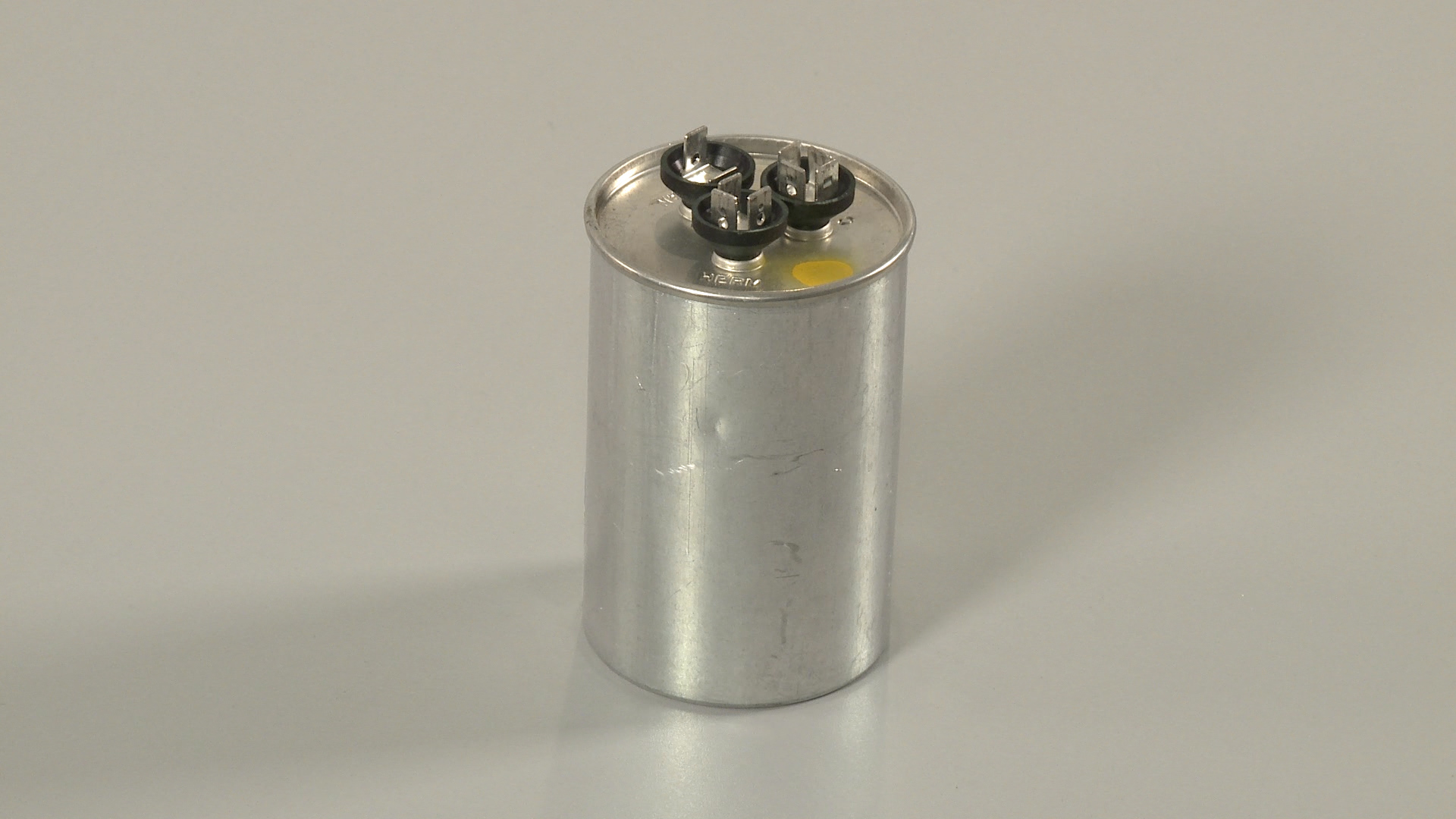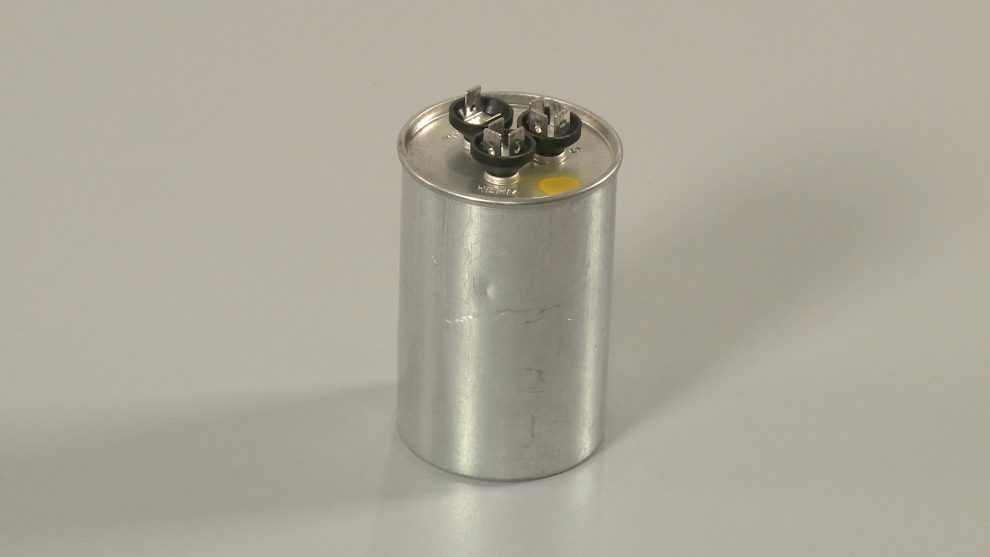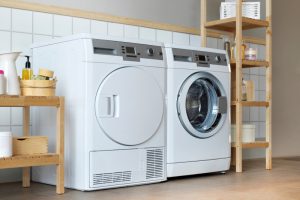
If your central air condensing unit fan motor or furnace blower motor aren't working, or your microwave oven won't heat, a defective run capacitor could be the culprit. A run capacitor is a powerful component. So powerful it retains a potent electrical charge even when the appliance or product it's installed in has been unplugged or the power supply has been shut off.
What does a run capacitor do?
Simply put, a single or dual run capacitor stores an electric charge and then releases it. The component is most often used to power motors and compressors, and can be found in central air condensing units, furnaces, along with other heating and cooling applications. Capacitors can also be found in appliances for example microwave ovens, refrigerators, even washing machines. A single run capacitor supports a single electric motor and is commonly used in small air conditioners and microwave ovens; a dual run capacitor will support two motors, the very first being a compressor and the second as being a fan motor. Products that have both a compressor along with a fan motor, such as furnaces and central air condensing units, will invariably rely on a dual run capacitor.
How to inform if a capacitor is bad
Over time, a run capacitor can weaken and lose its ability to hold a full charge. It can also fail completely. The motor or compressor being run by the capacitor will have trouble running smoothly or may not run at all. You can often tell that a capacitor has failed since the casing will bulge or leak. If you observe any bulging or leaking, the capacitor will need immediate replacement. If there are no visible indications of damage, the capacitor can be tested to determine if its working properly.
Testing the run capacitor with a multimeter
You can use an analog Ohm meter to test the capacitor's ability to store and release an electric charge. You can also test the component to determine if it has the proper capacitance rating by measuring the microfarads contained in the capacitor. This second test can be done using a capacitor tester or a multimeter having a capacitor testing function. IMPORTANT: To prevent shock before handling a capacitor, you should release the potentially stored electrical charge by placing a screwdriver blade across each group of terminals. Avoid touching the screwdriver blade when you are performing this.
Here's how you can use an analog Ohm meter to verify a single run capacitor can properly store and release a charge:
- Rotate the meter's range selection dial to some setting of 1000 Ohms or higher.
- Calibrate the meter, if necessary, by touching the black and red probes together as you set the needle to “0”.
- Use one probe to touch one of the capacitor's terminals and the other probe to touch the other terminal. The meter needle should deflect toward zero Ohms and go back to infinite resistance.
- Reverse the probes and you should get the same result.
- If the needle does not move or stays near zero Ohms, the capacitor has failed.
When checking a dual run capacitor, you will test between the common terminal and every of the other terminals:
- To test the fan circuit, touch one probe to the common terminal (often identified by the letter “C”) and the other probe to the fan terminal (usually recognized as “FAN”). As noted above, the needle should deflect toward zero Ohms then go back to infinite resistance.
- You can repeat the exam to determine if the third terminal, usually recognized as “HERM” or “COMP”, is functioning properly.
A standard Ohm meter can also be used to determine if the capacitor has shorted to ground:
- Place one probe on each one of the terminals while touching the 2nd probe to the side of the casing. No terminal should display continuity – a continuing electrical path.
- If the meter display does indicate electrical continuity, the capacitor has shorted and can need to be replaced.
It's also important to verify the capacitor actually has a capacitance rating that suits the one on the component's label. You will have to use a dedicated capacitor tester with this test or a multimeter that has a capacitor testing function. To identify the capacitance rating on a single run capacitor:
- Note the microfarad rating on the capacitor's label (Example: 7.5%).
- Choose the comparable setting around the tester or meter.
- Connect the probes to the terminals and press the tester or meter button to display the microfarad rating. The rating ought to be close to the one identified around the label. If the display shows the microfarads are lower, the capacitor has weakened and should be replaced.
Dual run capacitors have two microfarad ratings: a higher rating is typical for the HERM or COMP circuit (Example: +6%) along with a lower rating is typical for the fan circuit (Example: -6%). You should test each circuit separately to determine if the display readings closely match the ratings around the label.
Find the right run capacitor with Repair Clinic
Since there are literally thousands of capacitors available, you'll want to make sure you're purchasing the right replacement. This is where Repair Clinic can help. Start by entering the full model number of your appliance parts or cooling and heating product in the Repair Clinic website search bar. Next, select “Capacitor” in the part category filter accompanied by the appropriate part title, if required, to identify the specific capacitor you need for your application. Repair Clinic stocks genuine manufacturer capacitors from top brands like Goodman, Lennox, Carrier, GE, Samsung, LG, Frigidaire, and Whirlpool, so there's no doubt you'll find what you need.


















